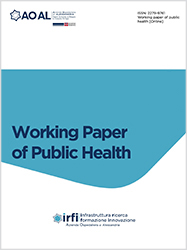Analysis of the care complexity in the surgical area: Persiceto’s score

All claims expressed in this article are solely those of the authors and do not necessarily represent those of their affiliated organizations, or those of the publisher, the editors and the reviewers. Any product that may be evaluated in this article or claim that may be made by its manufacturer is not guaranteed or endorsed by the publisher.
Introduction: In Italy a new way of thinking about hospitals is emerging. It involves the articulation of care and resources according to the intensity and the complexity of care; patients acquire a central role and are no longer grouped by medical disciplines but by high, medium or low care complexity. Purpose of this study is to test a tool that detects care complexity in the areas of intervention, calculating and analyzing the care complexity of surgical patients in their first day after surgery. Methods: adoption of the Swot method to specify the Persiceto's Score tool, adapted to the Alexandrian context. The Persiceto tool consists of scores obtained from three elements: type of surgery, state of health/concurrent disease condition, autonomy level of the patient in various activities. Results: In an evaluation period of about 60 days the Persiceto tools completed on the first day after surgery were 80. The state of health and concurrent disease condition of the 80 patients was constituted by 43 with moderate systemic disease, 22 with severe systemic disease, 13 in good health and 2 in threatening health conditions. The level of care dependency that emerged from the IDA assessment of the 80 patients was 56 with low care dependency, 23 with average and 1 with high care dependency. Conclusions: This study has shown that a simple, effective and replicable tool can be useful during the reorganization of care intensity during post-surgery to obtain a precise classifications of care complexity.
PAGEPress has chosen to apply the Creative Commons Attribution NonCommercial 4.0 International License (CC BY-NC 4.0) to all manuscripts to be published.

 https://doi.org/10.4081/wpph.2021.9252
https://doi.org/10.4081/wpph.2021.9252




